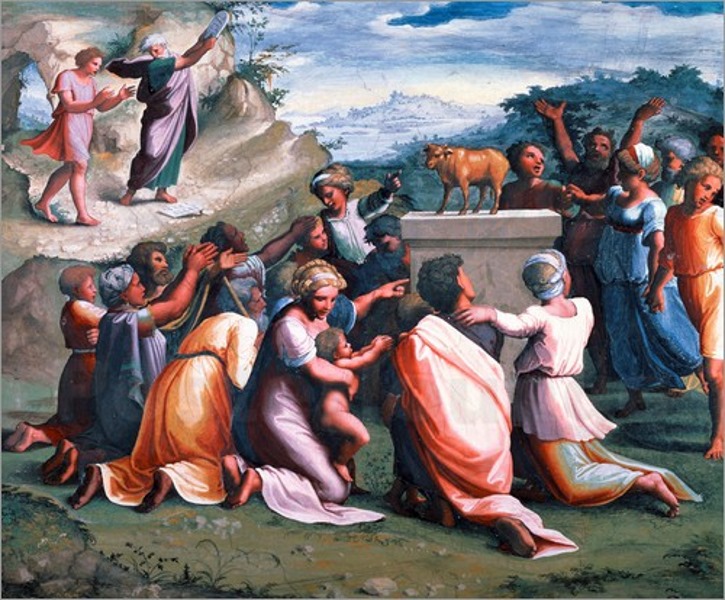Sin of the Golden Calf
Introduction


Moshe's Absence
The story of the Golden Calf opens with the backdrop for the nation's sin:
(א) וַיַּרְא הָעָם כִּי בֹשֵׁשׁ מֹשֶׁה לָרֶדֶת מִן הָהָר וַיִּקָּהֵל הָעָם עַל אַהֲרֹן וַיֹּאמְרוּ אֵלָיו קוּם עֲשֵׂה לָנוּ אֱלֹהִים אֲשֶׁר יֵלְכוּ לְפָנֵינוּ כִּי זֶה מֹשֶׁה הָאִישׁ אֲשֶׁר הֶעֱלָנוּ מֵאֶרֶץ מִצְרַיִם לֹא יָדַעְנוּ מֶה הָיָה לוֹ.
(1) And when the people saw that Moses delayed to come down from the mount, the people gathered themselves together unto Aaron, and said unto him: 'Up, make us a god who shall go before us; for as for this Moses, the man that brought us up out of the land of Egypt, we know not what is become of him.'
Ostensibly, Moshe's tardiness in descending from the mountain motivates the nation to request that Aharon make for them an "אֱלֹהִים אֲשֶׁר יֵלְכוּ לְפָנֵינוּ" ("a god who will go before us"). What, though, is the connection between Moshe's absence and their request? Is the Calf born out of an existential angst in which the people search to fill the theological void left by Moshe's disappearance? Or, is it merely the product of a practical need for visible leadership to help them navigate and survive the travails of the wilderness? Does the term "אֱלֹהִים" used here have a sacred ("god" / "gods") or a secular ("ruler" / "judge") connotation? Are the words "יֵלְכוּ לְפָנֵינוּ" meant in a spiritual sense or a physical one? Either way, how do the people think that a molten calf will provide the solution to their problems?
Sins of the Nation and Aharon
Tehillim 106 reviews many of the events in the Wilderness (and beyond) in which the Children of Israel waver in their faith in Hashem. Its verses appear to cast the episode of the Calf as an attempt to replace Hashem:
(יט) יַעֲשׂוּ עֵגֶל בְּחֹרֵב וַיִּשְׁתַּחֲווּ לְמַסֵּכָה. (כ) וַיָּמִירוּ אֶת כְּבוֹדָם בְּתַבְנִית שׁוֹר אֹכֵל עֵשֶׂב.
(19) They made a calf in Horeb and worshipped a molten image. (20) Thus they exchanged their glory for the likeness of an ox that eateth grass.
The possibility that the Israelites would seek to shift their allegiances to an idol, so soon after Hashem's miracles and revelation in Egypt and at Sinai, is deeply troubling. However, as per the context in the chapter of Tehillim, this is merely part of a long litany of instances in which the nation displays such a rebellious streak. What is unique, though, in the case of the Golden Calf is that Aharon played a lead role in the events.1 Is it possible that Aharon was involved in an idolatrous rite, or is it blasphemous to even ponder such a possibility? Moreover, how could it be that Aharon was rewarded so soon after by being consecrated as the high priest2 and that his actions did not compromise this appointment?
Additional Questions
- "חַג לַי"י מָחָר" – Throughout the story the people refer to the Calf as an "אֱלֹהִים",3 yet when Aharon builds the altar he announces that there will be a feast for "Hashem" tomorrow. Is there a significance to this difference? Is Aharon using the proper name of Hashem to refer to the newly made calf or to Hashem Himself?
- Why a calf? Was the choice to form specifically a calf arbitrary or intentional?4 If yes, who opted for it and why?
- Destroying the Luchot – How could Moshe break the Tablets, Hashem's own handiwork? Is this action simply a manifestation of fury, or is it a more symbolic representation of the breaking of the covenant?
- Drinking of the Calf's ashes – Why does Moshe spread the remains of the burnt Calf into the water and give of it to the nation to drink? Is this a punishment, test, or an educational tool?
- Aharon's self defense – In justifying himself to Moshe, Aharon seems to simply repeat the facts and then blame the "evil" nature of the nation, while belittling his own active fashioning of the Calf. How is this defense to be understood?
- How many people sinned? When Hashem speaks to Moshe while still on the mountain (verses 9-10), He considers destroying the entire nation. This suggests that all, or at least a vast majority, participated in the sin. Nonetheless, when the Levites heed Moshe's call to kill the perpetrators, only 3,000 are killed. On the other hand, Shemot 32 ends by stating that Hashem smote the nation. What percentage of the nation actually sinned? Did they all commit the same crime, or were there varying attitudes towards the Calf and perhaps different punishments meted out?
Polemics and Parshanut
The sin of the Golden Calf was one of the spiritual nadirs of the early history of the Children of Israel, and it was seized upon by Christianity in its attempt to both demonstrate the stiff-necked nature of the Jewish people and rationalize that fulfillment of the Torah's commandments was required only for those who had sinned with the Calf. Given the centrality of the story for religious doctrine, it is not surprising to find that Jewish exegetes attempt to relate and respond.
While Jews living in Islamic lands were less affected by the national aspect, they encountered the Muslim doctrine of prophetic infallibility, and this may have impacted their readings of Aharon's actions. In Approaches, we will survey how Biblical commentators living in different countries and eras interpreted the sin, and explore some of the impact of these polemical factors.